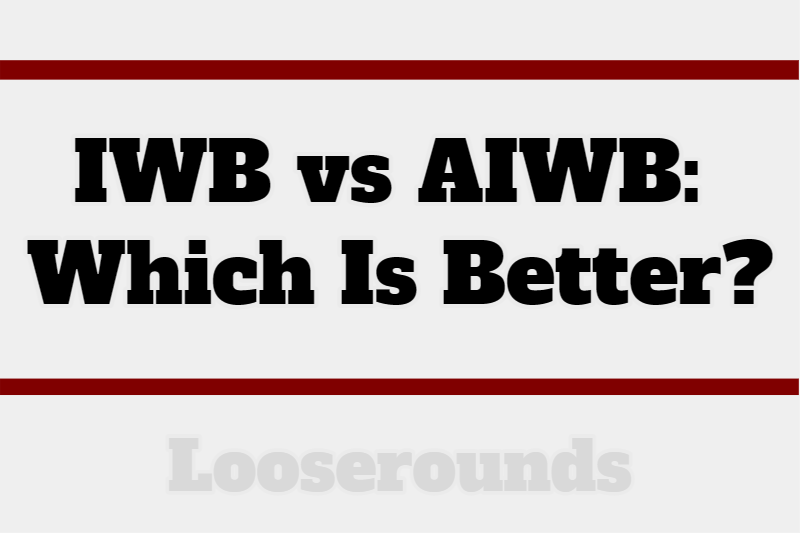
Both IWB and AIWB holsters have their own unique benefits and drawbacks.
In this blog post, we will delve into the pros and cons of both of them.
We’ll compare them on their:
- Comfort
- Concealment
- Accessibility
- And safety
We’ll also give you some tips on how to SAFELY carry AIWB while addressing common concerns.
In other words –
No, you won’t shoot your junk off with AIWB.
Ready? Let’s get started…
IWB vs AIWB Holsters: A Comparison
Let’s evaluate the advantages and disadvantages of both IWB and AIWB holsters to determine which option is best for you.
IWB vs AIWB Concealment: AIWB Is Usually Better
In terms of concealment, AIWB carry often has the edge.
With its position at the front of your body, AIWB is easier to hide under clothing than IWB.
Especially tight-fitting clothing.
Traditional IWB holsters still offer good concealment but might require more strategic outfit planning.
Also, if you’ve got a bit of extra love around your midsection (hey, no judgment here), AIWB can provide better concealment than the traditional IWB position.
By positioning your firearm closer to the front of your body, it’s less likely to print or become exposed when bending over or reaching up.
IWB vs AIWB Gun Size: AIWB Better For Bigger Guns
With AIWB carry, you have the option of going for a holster claw to be able to carry bigger guns concealed.
The claw will push the grip of the gun against your body, allowing you to tuck away a bigger gun than you otherwise would be able with regular IWB carry.
Why?
With regular IWB carry, there’s a high chance that the grip of your heater would stick out, and print through clothing. With AIWB holster using a claw, that problem is solved by pushing the grip against your waistline, thereby tucking it in.
IWB vs AIWB Comfort: It Depends
There are pros and cons to each here, and this will depend more on your day-to-day activities.
- AIWB pros: Will be more comfortable with bigger guns
- IWB pros: Nothing digging into your stomach when sitting or bending over
This is really body-type dependent, so keep that in mind.
IWB vs AIWB Clothing Options: AIWB Wins
With AIWB, you can wear tighter clothing and still keep your gun concealed. That’s because there’s little curvature when you’re carrying in the front of your body.
With IWB, tight-fitting shirts and pants will cause printing issues, that’s almost guaranteed.
A significant advantage for AIWB carriers is quicker access to their firearms compared with those using traditional IWB holsters.
Now, the difference is not massive with proper training. But still, I have to give AIWB a slight edge here.
IWB vs AIWB Safety Concerns: IWB Slight Edge
While there is little risk with AIWB carry, there’s still the issue of muzzle direction that I have to mention.
Muzzle direction: With traditional IWB carry positions (like 4 o’clock), there’s less risk of accidentally pointing the muzzle at yourself during daily activities than with AIWB.
Again, with proper training and carrying a holster that checks all safety boxes, this is not an issue.
Bonus: Will You Shoot Your Junk Off with AIWB?
Let’s address the elephant in the room, or should I say, the gun near your junk.
Many people are worried about accidentally shooting their family jewels while carrying AIWB.
Fear not. There’s actually zero risk of that happening if you have proper draw technique and use a quality holster.
AIWB holsters are designed to keep your trigger guard covered and secure at all times. This means there’s no chance for an accidental discharge as long as you follow some basic safety rules:
- Finger off the trigger: Keep your finger straight along the frame until you’re ready to shoot.
- Muzzle discipline: Always be aware of where your muzzle is pointing, even when drawing or reholstering.
- Holster selection: Choose a quality AIWB holster that covers and protects the entire trigger guard area.
The key here is practicing safe handling techniques consistently.
If done correctly, carrying AIWB poses no more risk than any other carry method. In fact, it can offer better accessibility and concealment compared to traditional IWB positions.
To further ease your mind (and protect those precious jewels), consider taking a class specifically focused on appendix carry from reputable instructors like ShivWorks’ ECQC course.
They’ll teach you everything you need to know about safely drawing and reholstering from an AIWB position.
IWB vs AIWB FAQs
Is it Better to Carry IWB or AIWB?
The choice between Inside-the-Waistband (IWB) and Appendix Inside-the-Waistband (AIWB) depends on personal preference, body type, and clothing style. IWB offers more comfort while sitting but may be harder to conceal for some individuals. AIWB provides quicker access to the firearm and is easier to conceal for slimmer body types.
What is the Best Form of Concealed Carry?
There isn’t a universally “best” position of concealed carry as it varies based on individual preferences, lifestyle factors, clothing choices, and specific firearms used. Popular options include IWB, AIWB, pocket carry, and others.
Conclusion
Side note: We tried to write in an easy way, but if there’s still something that you find difficult to understand, here’s a quick list of holster terminology for beginners.
So when it comes to IWB vs AIWB holsters, there are pros and cons to each
Traditional IWB holsters offer comfort and versatility, while AIWB holsters provide better concealment and faster draw times.
Before deciding which holster is right for you, consider your body type, clothing choices, firearm size, and level of training. Always remember to prioritize safety above all else.
To learn more about how we work and earn our living, read more about who we are or take a look at our editorial guidelines (work in progress!)
